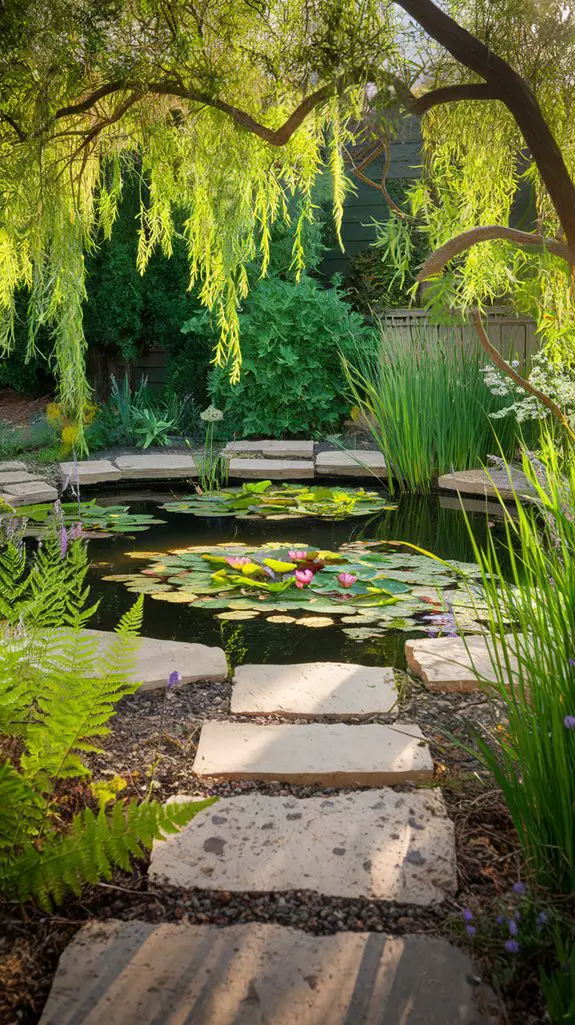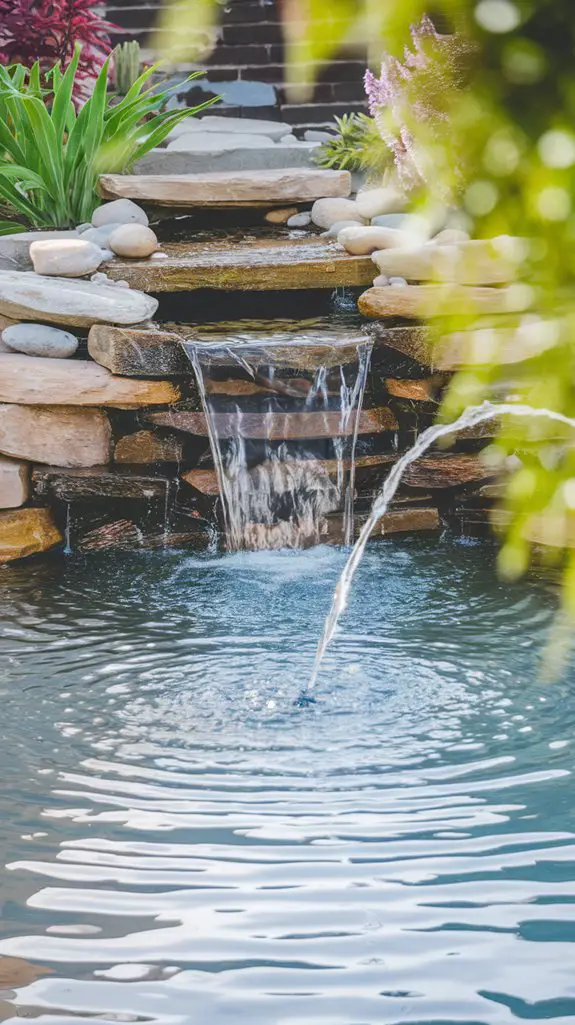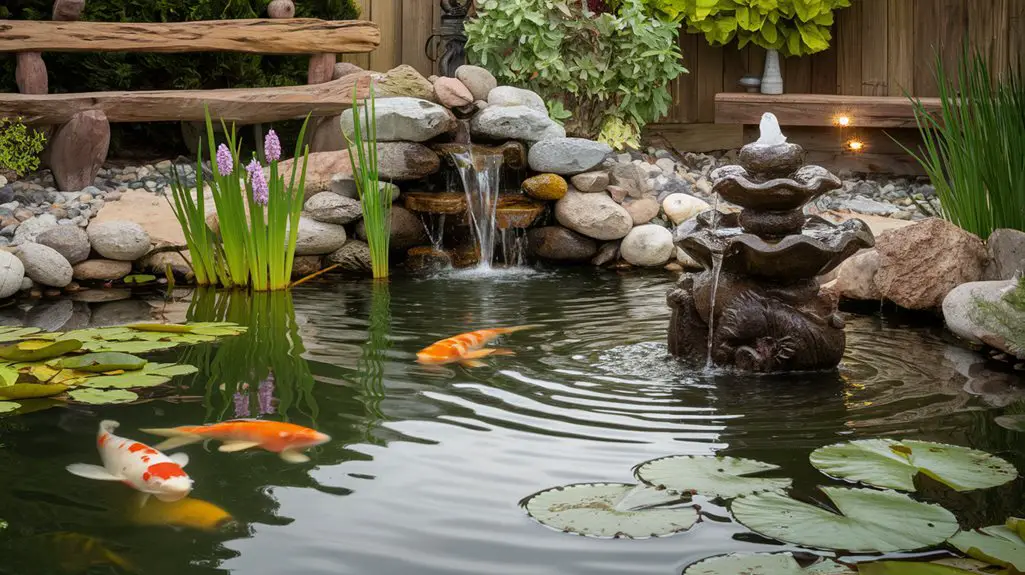Creating a DIY backyard pond can transform your outdoor space into a serene oasis. You'll need to carefully evaluate the location, size, and materials to guarantee a thriving ecosystem. By incorporating natural elements and aquatic plants, you can enhance both beauty and functionality. But that's just the beginning; there are essential features to examine that can elevate your pond to the next level. Let's explore these key tips to help you get started.
Choose the Right Location
When deciding where to place your backyard pond, how do you make certain it thrives in its environment? Start by observing sunlight exposure; most aquatic plants need at least six hours of direct sunlight daily. Avoid placing it under trees, as falling leaves can lead to excess debris and algae growth. Next, consider the slope of your yard. A gently sloping area allows for better drainage and prevents flooding. Check for proximity to a water source; easy access makes filling and maintenance simpler. Ultimately, think about visibility. You'll want your pond in a spot where you can enjoy its beauty, but not so close that it disrupts your daily activities. Finding that balance is key to a flourishing pond. Additionally, incorporating water features can significantly enhance the attractiveness of your pond to local wildlife.
Select the Perfect Pond Size
After you've chosen the right location for your backyard pond, it's time to determine the perfect size.
Consider your available space, as well as the dimensions of your yard. A smaller pond can create intimacy, while a larger one can serve as a focal point. Aim for a depth of at least 18 inches to support aquatic life.
For fish, a size of at least 100 gallons is ideal, allowing them room to thrive. Think about the shape too; a winding design can add interest.
Visualize how the pond will interact with your landscape, ensuring it complements your garden.
Finally, don't forget to leave space for plants and features around the pond's edge to enhance its beauty and functionality. Additionally, incorporating solar-powered features can significantly improve the aesthetic and sustainability of your pond.
Incorporate Natural Elements

Incorporating natural elements into your backyard pond transforms it from a simple water feature into a vibrant ecosystem. By adding these components, you enhance both the beauty and functionality of your space.
Consider these three essential elements:
- Rocks: Use various sizes to create natural ledges and hiding spots for fish and aquatic life. This adds visual interest and promotes biodiversity.
- Logs: Fallen tree branches or driftwood can serve as perches for birds and basking spots for turtles, while also aiding in natural filtration.
- Gravel: A layer of gravel at the pond's bottom mimics a natural riverbed, providing habitat for beneficial bacteria that help maintain water quality.
Additionally, the right plants around your pond can further enhance the ecosystem by providing shade and habitat for wildlife. These natural additions will attract wildlife and create a harmonious environment in your yard.
Add Water Plants for Aesthetic Appeal
Adding water plants to your backyard pond not only enhances its visual appeal but also contributes to a balanced ecosystem.
Choose a mix of submerged, floating, and emergent plants to create layers of interest. Submerged plants like anacharis oxygenate the water, while floating plants like water lilies offer shade and shelter for fish. Add emergent plants, such as cattails or rushes, along the pond's edge for texture and height.
Be mindful of spacing; overcrowding can lead to competition for nutrients. Regularly prune and maintain these plants to keep them healthy.
Additionally, consider seasonal changes—plant varieties that bloom at different times to guarantee year-round beauty. By thoughtfully selecting and arranging water plants, you'll create a serene and inviting aquatic haven. Incorporating best plants for attracting backyard wildlife will further enhance the biodiversity of your pond.
Consider Water Features Like Fountains and Waterfalls

While you might envision a tranquil pond with still water, incorporating dynamic elements like fountains and waterfalls can elevate your backyard oasis.
The soothing sound of flowing water not only enhances the atmosphere but also attracts wildlife, creating a vibrant ecosystem. Additionally, incorporating creative water features such as splash pads or interactive streams can further engage kids and encourage outdoor play.
Here are three ideas to contemplate:
- Tiered Waterfalls: Create a multi-level waterfall that cascades gently, providing visual interest and a calming soundscape.
- Solar-Powered Fountains: Opt for a solar fountain to add movement without increasing your energy bill, perfect for sunny days.
- Wall Fountains: Install a wall-mounted fountain to save space while adding elegance and a unique focal point to your pond area.
Use Quality Materials for Durability
When you're building a backyard pond, choosing quality materials can make all the difference in ensuring its longevity and functionality.
Start with a durable pond liner, preferably EPDM or butyl rubber, to resist UV rays and punctures. Use reinforced concrete or natural stone for edging; they not only enhance aesthetics but also provide stability.
When selecting pumps and filters, opt for energy-efficient models that are designed for your pond's size, ensuring ideal water circulation. If you're adding lighting, choose waterproof, LED fixtures to prevent electrical hazards.
Finally, use non-toxic sealants and coatings to protect aquatic life. Investing in these quality materials now will save you time and money in the long run, allowing you to enjoy your pond for years to come. Additionally, consider incorporating eco-friendly water features that can enhance the sustainability of your garden.
Maintain Your Pond Regularly
To keep your backyard pond thriving, regular maintenance is crucial. Neglecting your pond can lead to murky water, algae overgrowth, and unhappy fish.
Here are three key tasks to incorporate into your routine:
- Clean the Filter: Regularly check and clean your filter to guarantee peak water flow and clarity. A dirty filter can harm aquatic life and create an unpleasant environment.
- Monitor Water Levels: Keep an eye on water levels, especially during hot weather. Top off the pond with dechlorinated water as needed to maintain balance.
- Remove Debris: Skim the surface for leaves, twigs, and algae. This not only keeps your pond looking pristine but also prevents harmful bacteria from developing.
Conclusion
Creating a DIY backyard pond isn't just a project; it's a journey into tranquility. Did you know that a well-maintained pond can support over 100 species of wildlife? Imagine the vibrant life flourishing in your backyard! By following these tips, you'll transform your outdoor space into a serene oasis, attracting birds, frogs, and butterflies. So roll up your sleeves, embrace your creativity, and let the soothing sounds of water and nature become your daily escape.




